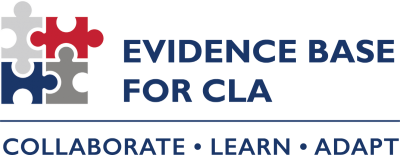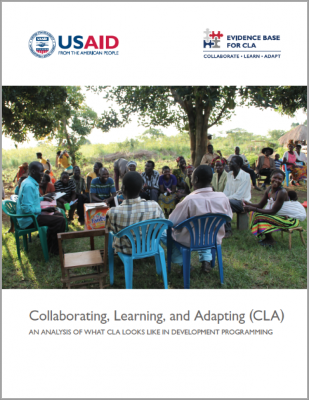Three Ways Collaborating, Learning, and Adapting Make a Difference: What We've Learned from our Analysis of 2015 CLA Case Competition Submissions

I’m right there with you. You’ve hung the Collaborating, Learning, and Adapting (CLA) Framework inside your cubicle. You’ve read the blogs on adaptive management, organizational culture, and resourcing CLA. You might have joined the CLA Community of Practice. But, you still have a lingering question: What does collaborating, learning, and adapting look like on the ground? We hope that after reading our analysis of the 2015 Collaborating, Learning and Adapting (CLA) Case Competition submissions, you’ll have a better answer to that question.
I know I do.

On the heels of the 2017 CLA Case Competition submission period, we’re excited to share a few key takeaways from the 2015 CLA Case Competition analysis. Based on a review of the 32 highest scoring entries from 2015, these findings demonstrate how integrating CLA into our work contributes to improved organizational effectiveness and, in several cases, better development outcomes. We hope you and your colleagues can use these findings to be more intentional and strategic about how you integrate CLA into your work, and ultimately achieve better results in your own programming.
So what did we find? This blog only covers some of the highlights; check out the brief and full report to learn more.
Finding 1: Local engagement leads to local ownership and, ultimately, improved development outcomes. Several of the cases we reviewed demonstrate that engaging with local stakeholders contributes to their increased ownership, which in turn can lead to better development outcomes. The example below shows that when implementing partners invite local stakeholders to participate in activity implementation, they become agents of their own change process and are motivated to achieve desired development outcomes.
Finding 1 in Action: Local Engagement Helps Curtail the Spread of Ebola in Liberia
When Ebola struck Liberia and eventually spiraled into an epidemic, Global Communities realized it needed to help curtail the epidemic via improved dead body management and safe burials. However, communities were skeptical of Global Communities and even attacked staff members and their vehicles. Residents wanted to know: “Why do you only come when someone has died? Why do you not come to help when someone is sick?”
As a result, Global Communities had to quickly shift tactics and meaningfully engage community members, particularly traditional leaders, to support safe burial. Because of this intentional relationship building, traditional leaders were willing to educate their community members about Ebola transmission and accompany burial staff for safe and peaceful burials. As a result the number of safe burials increased and Ebola transmission rates declined.
Other cases that support Finding 1 demonstrate how local engagement improved sanitation in Zambia, savings groups in Uganda, and livelihoods in global programming.
Finding 2: Intentional knowledge management generates standard good practices for broader application. The cases contributing to this finding demonstrate how capturing knowledge and sharing best practices derived from that knowledge can contribute to improvements at the organizational level. Moreover, knowledge dissemination can also lead to scale-up of good practices.
Finding 2 in Action: Knowledge Management Supports Effective Resilience Programming
The Sahel Resilience Learning (SAREL) activity provides monitoring, evaluation, collaboration and learning support to USAID’s Resilience in the Sahel-Enhanced (RISE) initiative. SAREL, implemented by International Resources Group, a subsidiary of Research Triangle Institute (RTI) International, addressed a lack of a shared collaboration and learning platform among RISE partners by
- Identifying and mapping proven technologies and approaches implemented by partners that have helped make vulnerable families more resilient
- Hosting knowledge-sharing events to validate best practices and identify opportunities for collaboration and
- Producing briefs on best practices and uploading them to a shared online platform.
Other cases that support Finding 2 demonstrate how intentional knowledge management supported improvements to safe male circumcision in Uganda, health worker management, and preventing mother to child transmission of HIV.
Finding 3: Feedback loops increase the likelihood that evidence will inform decision-making. The cases illustrating this finding describe how specific tools and processes for creating feedback loops provide continuous learning to inform decision-making.
In generating feedback, teams and organizations analyze learning, make decisions based on that learning and then follow through on decisions reached.
Finding 3 in Action: Real-Time Feedback Supports Adaptive Management in Uganda
To improve literacy rates and reduce HIV transmission among primary and secondary school students, the Ugandan government designed an integrated education and health strategy. USAID/Uganda supports this approach through the School Health and Reading Program (SHRP), implemented through RTI International. The mission awarded a Performance and Impact Evaluation mechanism (P&IE) to Panagora Group with the goal of providing monitoring, evaluation, and CLA advisory services to RTI.
Panagora Group developed a multi-stage approach to continuous learning by providing RTI with real-time performance information needed to inform adaptive management decisions and actions that could, in turn, lead to improved results. The case specifically highlights how this approach helped RTI improve a training.
Seven additional cases support Finding 3 and include examples of how real-time data led to greater responsiveness in the aftermath of the 2015 Nepal earthquake, a midterm evaluation resulted in changes to an activity’s theory of change and overall approach, and routine data collection in Haiti informed where best to allocate resources.
What implications do these findings have for USAID and implementing partners?
Investing in CLA bears results. But are we willing to invest? The cases illustrate how investing in CLA practices and approaches provides a range of valuable contributions to organizational change and development outcomes. This suggests that USAID staff and implementing partners should protect and, in many cases, expand investments in CLA integration.
CLA begets CLA. Several cases underscore that when stakeholders learn about positive outcomes linked to a CLA approach in another organization, they adapt the approach to their context. By effectively modeling CLA, organizations can perhaps more credibly share its benefits with other development actors and inspire them to integrate CLA into their own work. In other words, “experiencing is believing” and those who experience CLA are more likely to incorporate CLA into how they operate.
Thank you to all of the 2015 CLA Case Competition contributors! Without your case competition submissions, this analysis would not have been possible. The brief, found here, features the CORE Group Polio Project, Global Communities, International Resources Group, a subsidiary of Research Triangle Institute (RTI), Panagora Group, and CARE. The full report features many other implementing partners and USAID missions.
This analysis is part of a larger effort known as the Evidence Base for Collaborating, Learning and Adapting (EB4CLA) to understand whether and how strategic collaboration, continuous learning and adaptive management make a difference to organizational effectiveness and development results. For comments and questions, please reach out to [email protected] or [email protected].



